Petru & Claymoor bespoke shoes: Review
Almost a year ago, back in January, I began the process of making a pair of bespoke shoes with a new outfit in Romania, Petru & Claymoor.
Shoe fans might have seen some coverage of the brand over the intervening year. It was set up by Mircea Cioponea and Petru Coca, the former better known for his shoe blog Claymoor’s List.
The pair have a showroom in Bucharest, and also a workshop in Brasov. The latter is in the Transylvania region of Romania, hence the use of ‘Transylvania’ on a lot of their branding and communications.
The split-toe derbys they made me were very nice, with a solid fit. There are one or two making issues, and a more significant one in the style that I’ll describe in a moment. They’re also the stiff, solid shoe typical of eastern Europe, which won’t suit everybody.
But it’s hard to argue with the value: €1500 for a completely handmade, bespoke shoe (€250 of which is the last - so not chargeable on a second pair).
This was also my first experience of having any bespoke done remotely - which has of course becoming more common in the past year. So that was interesting to experience and think about.
We began the experience by Mircea sending me images of their models, in various leathers, and me picking between them. Unfortunately some of the leathers proved to then be unavailable, so I couldn’t get the shade of kudu I liked. I find this a risk with older shoe models or smaller makers.
But there was a split-toe derby in the Russian hatch-grain leather supplied by Horween, which I liked, so we went with that (pictured above).
I was instructed to measure my own feet, in four different places on each foot. I then sent Mircea a video of me doing so (in order to see exactly where I had measured) as well as the measurements themselves.
This was a relatively few number of measurements, compared to what a bespoke maker would usually take in person, for instance.
The process was then delayed by Covid, and we started again in June.
I was sent a fitting pair of shoes, made in a scrap leather with a temporary, glued sole (above). We then had a video call to see and discuss the fit. The shoes were a different style - a cap-toe oxford, rather than a Norwegian derby.
Overall, it was good. There were a few changes to make, and it had perhaps erred on the safe side in terms of generosity of fit, but it felt like a good start.
The finished shoes were then received in October, and I have to say packaged very nicely.
The shoe boxes Mircea is using are actually wine boxes, made from Transylvanian beech, and he included a bottle of wine from the local vineyard owned by his friend Mosia Galicea.
The box is wider than other bespoke shoe boxes as a result, and has a sliding lid, which is pleasing. The cloth and shoe bags were from a dark-grey tailoring material, and my initials were stamped on the side.
The make of the shoes overall was strong. The work is clean and well done, with smooth transitions between sole and heel, and neat hand-sewing on the apron, for instance. There were some attractive touches, like the aged-brass aiglets on the ends of the laces.
The shoes were also nicely polished, with darker colour on the toes, which really brings out the character of the hatch-grain. However it was a little messy near the welt, with some pale and dark patches.
Looking carefully, the balance of the uppers on the sole was also not perfect. From above, the welt appears wider on one side than the other, on both shoes.
This is a detail, and I doubt anyone would notice it that wasn’t analysing the shoes this closely. But at the same time, it’s also something I don’t see on my top-end bespoke shoes (Gaziano, Cleverley, Bemer, Fukuda etc) or on high-end factory-made shoes.
The shoes are entirely handmade, in the same way any bespoke - i.e. hand welted, hand-sewn welt, hand-sewn sole, machine-sewn parts on the uppers.
But they’re not a fine bespoke make. The heel is fairly square, neither narrowed to the waist nor pitched in the back, and with no clean transition from heel cup to stack. The waist is cut in, but not tightly, and the bevelling is subtle. (See post here for an illustration of those details.)
The shoe trees are also not solid or hollowed, being sprung models from Springline.
Of course, most of these are style points as well as making ones. Dressy touches would be out of place on a country shoe. But it does mean the shoe resembles some high-end non-bespoke - particularly Saint Crispin’s - more than it does other bespoke shoes we’ve covered.
The Saint Crispin’s comparison is worth dwelling on, because the overall style is very similar. As far as I know this is just because of the way shoes are made in the area: both workshops are in Romania.
But from a style point of view, I think it’s worth considering whether you like that Saint Crispin’s look, when considering Petru & Claymoor for a new bespoke option.
And, it’s worth considering whether you need the extra bespoke steps like a hand-sewn sole, when the lack of dressy details means that the look and feel is very similar to StC.
The fit of the P&C shoes was very good, which was a relief as this was the area I was most worried about, given so much had been done remotely.
The fit through the back of the shoe is close without being restrictive, while there’s plenty of room to move the toes. Although, this is something that's easiest to achieve on a derby style. Most ready-made derbys fit me well (unlike oxfords, loafers or boots) and so this is only a slight improvement.
The only real fit issue is on the vamp of the shoe, where the toes meet the foot. Here the shoes are cut rather close, before lifting up into a fairly tall toe box. This makes them a tiny bit less comfortable, but also affects the look of the shoe - accentuating the creases and separating the toe area, as you can see to an extent in the images above and below.
The significant style issue that I alluded to at the beginning is the width of the shoe.
Mircea said he deliberately created a wide shape at the front, in order to give me plenty of room for my little toes. He was aware from other articles that this was my biggest pain point, and issue with shoe fit generally.
He was right to focus on that, but I think overcompensated. The result is a rather unusual, almost bulbous shape to the front that I don’t think quite comes across from the pictures.
Indeed, when I received the shoes I was excited about how lovely they looked, but a little taken aback at this shape. I discussed it with Mircea, and he explained the reasoning above, as well as of course saying that it could be changed on a future pair.
If I compare it to the shape of the Saint Crispin’s I had made four years ago, because they have a similar last, I find those more subtle and elegant.
The last thing worth mentioning is that the Petru & Claymoor shoes are very stiff. Probably the stiffest shoes I’ve worn.
This is partly the way eastern European shoes are made. As with the lack of dressy details, these are just not fine city shoes, and are deliberately robust. But it’s also a little the leather, which is thicker than most calf, around 1.8-2mm.
I’ve worn the shoes about 10 times so far, and they are softening, but remain noticeably stiff and a little tiring on the feet as a result. It will probably take another 10 or 20 wears to know how much they will really soften up.
I think that stiffness and the unusual shape are what would hold me back from getting a second pair of Petru & Claymoor.
I really like them, but I need to see in the long term both how much they soften and how much that shape bothers me. I would also really want to see Mircea in person, to point these details out and to see alternatives.
The team do plan to do trunk shows - to London, St Petersburg and Frankfurt - but obviously can’t at the moment.
I like the look of some other Petru & Claymoor styles, such as the chelsea boots shown above. And I’ve always wanted a brown-suede toe-cap in this style, as my Saint Crispin’s pair didn’t fit that well (one area in which P&C comes off better from the comparison).
But I think we need that physical meeting to resolve some of these issues.
And perhaps that’s the biggest disadvantage of a remote bespoke process: it’s hard to explain and correct any issues that do come up.
You might be lucky and not have any; but if you do, the customer’s lack of expertise makes it hard to fix them. That’s certainly something I’m finding in tailoring too - more on which soon.
Complete pricing: First pair €1500, including €250 for the lasts - €1250 for subsequent pairs. Price includes all calf and suede, such as the hatch grain shown. Other leathers price on request. There is also a MTO option on their signature last, from €990. Normal delivery time, six weeks.
Photography: Alex Natt, Petru & Claymoor, and Permanent Style


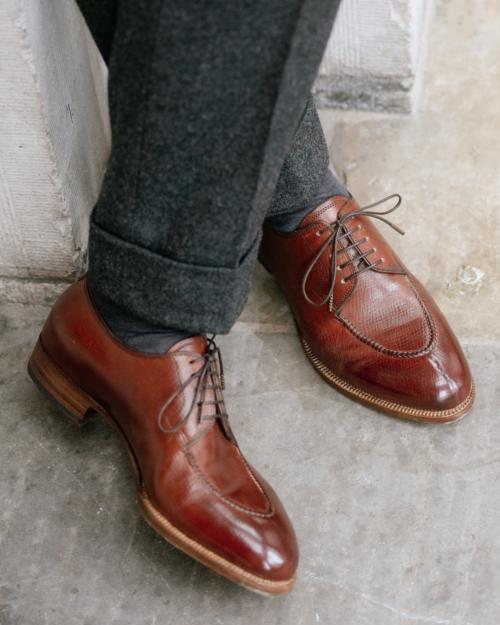
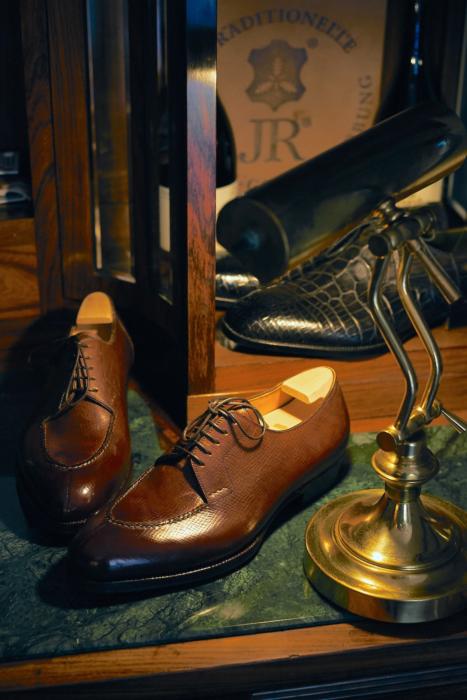
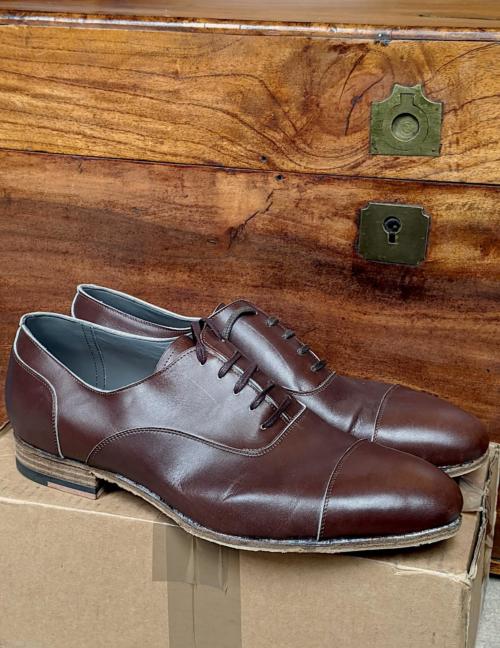
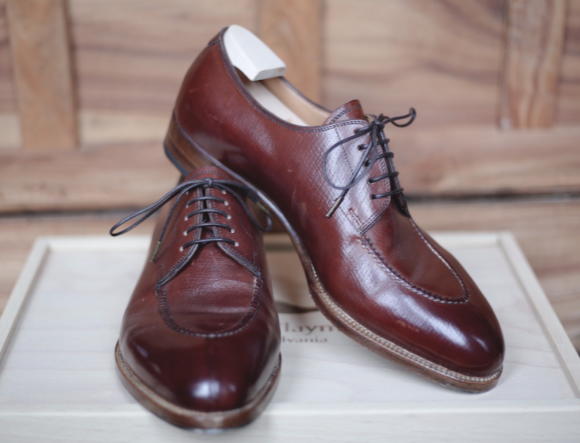
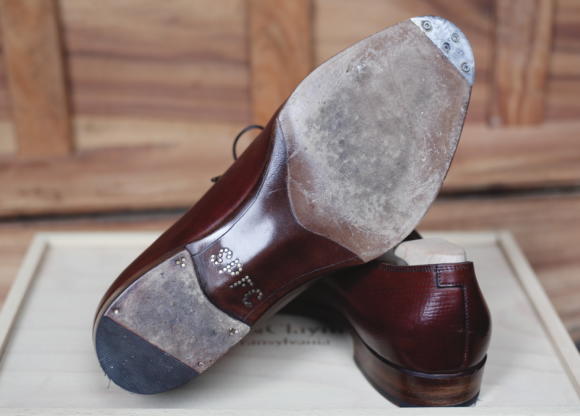
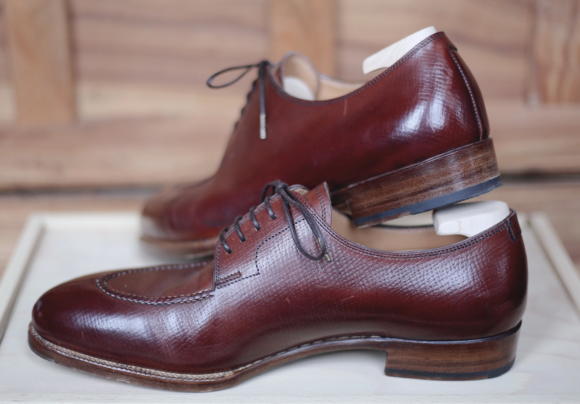
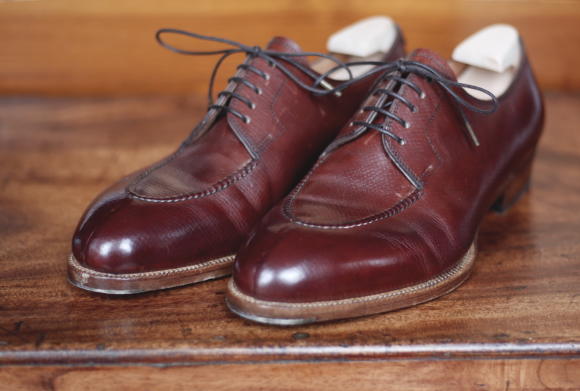
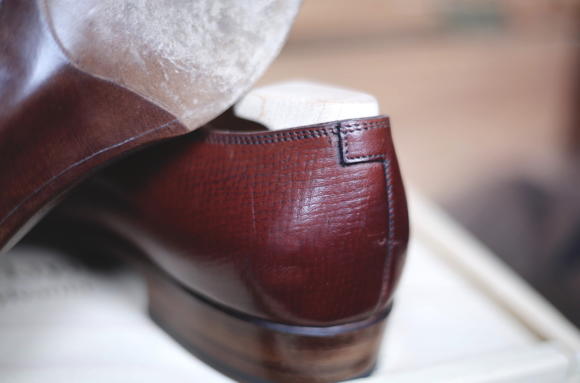
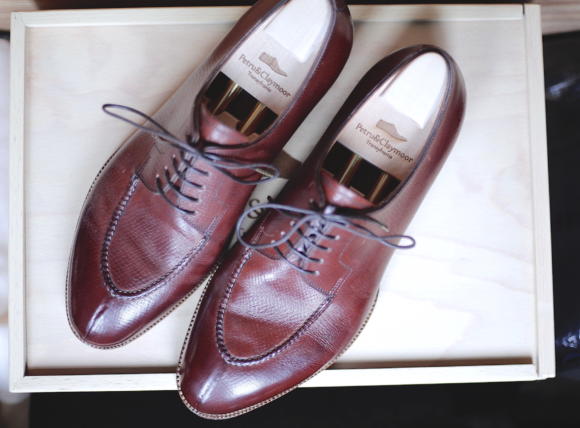
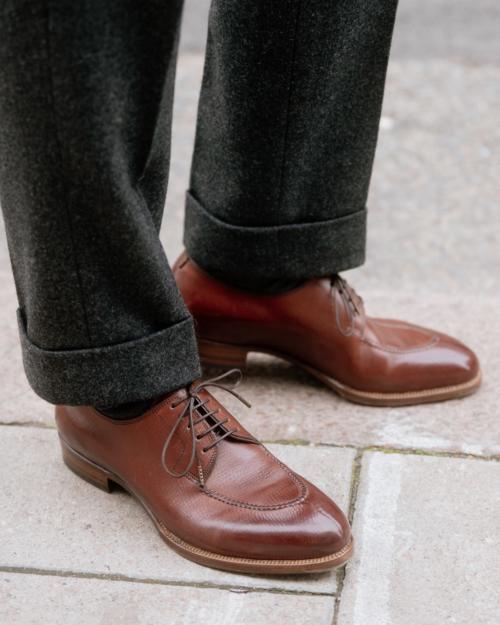
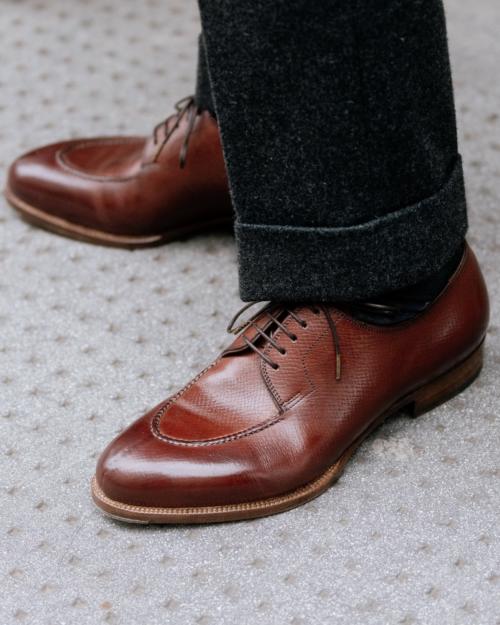
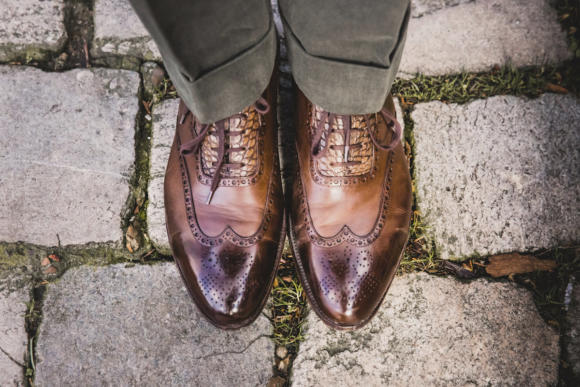
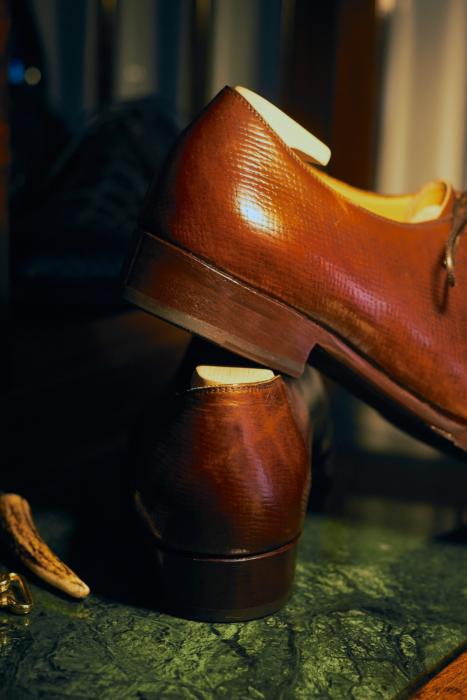
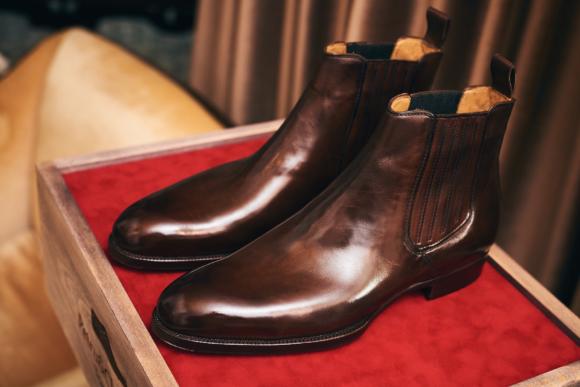
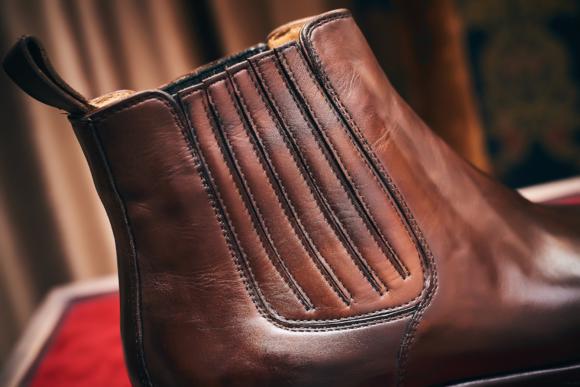
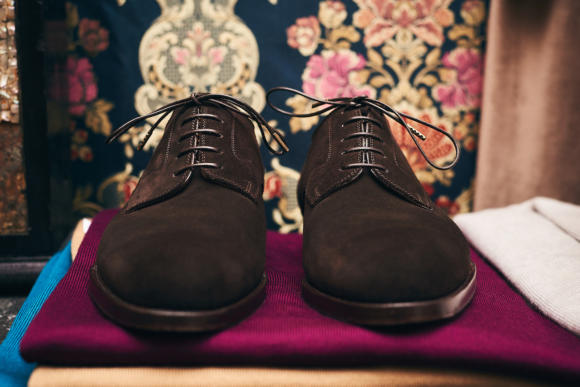
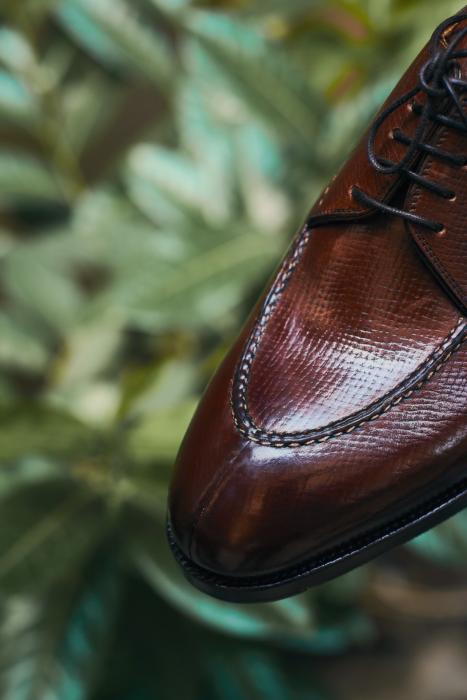


























Thanks Simon, beautiful shoes and probably very good value.
I actually have the similar shoe from St Crispins in the approximately same color. I really like the style but think the color makes them hard to use with tailoring. I have no problem using shoes like the EG Dover in dark oak with grey flannels but think that this more reddish brown is harder. I see that you use them with chacoal flannels but I think that the contrast is too large. Denim would be easier I guess. How will you use them in general?
Yes, true. The charcoal is probably not a great match, a mid-grey or paler would be better.
This colour of shoe is nicest with mid-shades like that, grey and green etc, then beige colours, sand etc
Hi Simon, is there any possibility that the stiffness you felt on this pair, as well as on your StCs, is partially due to the shape or/and size of your feet? I read your article on your first pair of StC before ordering mine, and since you emphasized the stiffness quite a lot, I was surprised that I actually don’t need any break-in after receiving mine. For me, in term of stiffness, StC is similar with Edward Green. Spain-made, relatively lower-end brands such as Carmina and Morjas are much more stiffer and need much more break-in.
For reference, my StC is a pair of oxford in size 6F, ordered during Phillip’s trunk show in London and he think I don’t need adjusted last for their shoes.
Hi,
No I don’t think so, so it’s interesting that you found that. The StC were stiff for me, and these are a touch more so, but I haven’t found that with EG
I’ll add that when I got StC shoes on a personal last, I was bracing for the stiffness, but found it was only slightly noticeable when wearing them over bespoke George Cleverleys. I can tell the leather is stiffer when handling them, but once wearing, I don’t notice it. Didn’t need much break-in, as with my Cleverleys.
More generally, I have found the experience of bespoke shoes inconsistent between people, and wonder if individual experiences with the same maker just vary widely. My George Cleverleys fit well but not to the level I’d have expected, and lack many style points (pretty square waist, no smooth transition at the heel cup to stack). I’d hoped pointing these out before a second shoe would help, but saw no improvement in the style, and actually worse fit. Obviously, others seem to have much better experience.
A local bespoke maker nailed the fit (though it took 5 fittings), but the style wasn’t great–similar bulbous issue you have. Being a much less expensive major finer points are also missing (pitching of heel, etc.), but that was expected at that price. However, other shoes by the same maker have turned out much better in style.
StC on a personalized last has actually done the best overall–not perfect in fit, but better than Cleverley, and very good in style (perhaps because they’re just adjusting a last, and not drawing a new pattern).
Dear Simon, great review and thanks for sharing. I also had some positive experiences made this year during Covid with remote bespoke at another east European maker in Polen, just without the extra step of a trial shoe. The result was quite good, but the shoes were a bit on the wide side. So I think the approach from P&C is better by including this step. Btw. the Chelsea model is really nice, has this design been used elsewhere or is it their invention? Thanks
Thanks, interesting to hear.
The chelsea is nice, isn’t it? Which part were you looking at as regards originality? The leather-covered gusset certainly isn’t original
Regarding breaking-in a new pair of shoes, bespoke in particular, how would you define a “wear”. Would this be a full day (8hrs+) or something shorter at first? Any advice on how to break-in a new bespoke shoe, would be appreciated.
Yes, when I say a day’s wear, it’s pretty much a working day or longer, although realistically the first couple of times I will wearing them more like 3-4 hours, perhaps around the house, to the shops etc, rather than into town.
That’s also the advice I’d give on breaking in bespoke shoes, though how much they will actually need it will vary a lot with the maker. My Cleverleys or G&G shoes needed almost no breaking in, for example, these are taking a lot, and Stefano Bemer was somewhere in-between
Hi Simon,
The design of this shoe is really lovely. So I do not share at all the aesthetic perspective from which you seem to assume in this post, as we have to do with a pair of derby and not oxfords. If it were a pair styled as the latter I would have agreed with you. Thus comparing it to the St Crispin as you did here doesn’t make sense to me, for we have before our eyes a real traditional pair of derby as known in the history of modern shoemaking. Zero chance to stumble upon a shoe designed this way as RTW today. And when it comes to bespoke, honestly I’m not impressed by the standardization of aesthetic features steming from a specific style of shoes – the oxfords – we see nowadays translated into even boots. See your own comment on Carmina Chukka boots as a case in point.
I hope it makes sense to you.
John
It does, thanks John. Good points
Excellent article, thank you very much for your hard work
Is it intentional that the sole extends so much beyond the “body” (don’t know the technical term) of the shoe in the front part?
Other than that, I see your points, but I feel like the main problem with these shoes is the reddish leather, with light brown soles, and the light stitching. I have a hard time imagining how this would ever look elegant, even with a sleeker last and finer details (I also have to say that the Saint Crispins are equally ugly in my opinion, reminds me of some of the abominations the likes of Riccardo Freccia Bestetti would sometimes produce). I mention that because you usually seem to have a quite subtle taste and a preference for muted colors.
Loosely related to this, could you write a piece on the “bespoke” shoemaking scene around Shanghai and the various brands that produce there? I am usually quite skeptical, but the pictures I have seen from Acme, Mori of Shoemakers, etc. look surprisingly good…
Cheers, Felix
Thanks Felix.
I think you’re referring to the thickness of the welt – and therefore how much that protrudes around the edges of the shoe. This is intentional, but is a style thing and can be adjusted. It’s also more noticeable the paler the welt is.
I haven’t tried Acme, but my experience of Mori has been a little patchy so far. The first pair that Maslow gave me had the sole peel off a little, and the replacement was good though the leather quality not quite as good as the sole work. It’s also been over two years with no real launch yet. I’m sure they’ll get there, and they certainly look impressive, but I think they’ve had their issues.
Thanks Simon, yes, that’s exactly what I meant. Maybe this even adds to the “bulbous” shape in this case.
Interesting points regarding the Chinese makers, sounds like its just a question of time until they become fully competitive? It doesn’t seem like a categorical difference whether to run workshops in remote Transylvania or in Shanghai in any case. I feel like a main criticism is that they simply copy popular styles from British producers, but then again the latter also often enough just reiterate something Nikolaus Tuczek has invented 60 years ago.
I’m about to order from Mori (talking to Maslow on IG they are open for orders and can deliver within a couple of weeks), will post a comment somewhere here on my experience.
Thanks Felix, do let me know
So, either the Saint Crispin’s workshop isn’t exactly their own or, at the very least, someone at the Brasov workshop has defected – many of the exact same patterns, same lasts, same materials for the most part, same trims, etc.
I don’t think you can necessarily conclude that. The same lasts, perhaps, but not the same trims or materials. There aren’t that many tanneries
Something did not look right with them, and then you said “The result is a rather unusual, almost bulbous shape to the front that I don’t think quite comes across from the pictures” and that’s it…. the seem flat and low then bulbous as you said. I like the leather but the shoe fails for me.
Agreed. I have RTW shoes that fit better. However, the real problem is the process. Bespoke does not work remotely. Only personal service, face2face, can deliver an excellent fit. Anything else is MTO or MTM at best.
Very interesting read. Look forward to seeing the discussion of remote bespoke for tailoring. When I went to Burgos last year I knew I’d have to make adjustments to shirts remotely on future orders, but seemed smooth enough. The second shirt maybe got a bit tight because of darts, but my latest shirt (third shirt) was about perfect (with darts). However, even then I’d say that I could benefit from seeing them in person again. Similarly, for more casual shirts it’s been a smooth process with Proper Cloth. I think they do a great job remotely and with adjustments to orders, but it is not quite the same as MTM I’ve had measured in person.
I know tailors are offering remote fittings, but a “remote” MTM or Bespoke suits frightens me.
Interesting as always Simon, thank you for that. Was the lighter shade sole a deliberate choice? Maybe it’s the pictures but it does change the whole look of the shoes. Would a dark brown in the same shade as the laces and the welt on the apron possibly work better?
Yes, potentially, and no it wasn’t a deliberate choice. It will darken over time though, and a little dark polish helps too
I think so. I have a pair of oxfords from Saint Crispins in a very similar red brown hatch grain and ended up using lots of dark brown and even black polish, not just on the soles but everywhere, to make them easier to wear. I love them by the way, but difficult to wear
Honestly, you have better ones. But is important to give credit to a good artisan. Craftmanship is so rare nowadays and must not be frustrated. I’ve succeded in getting excellent suits, after poor prior attempts, from unknown tailors. Insisting with them about details and making them well aware of what I exactly wanted. When it works, is very, very satisfying. You are doing well promoting them.
It sounds like you have slightly “awkward” feet, which is something I share: very wide feet with a high instep. In RTW shoes I almost invariably have to size up at least 1.5 sizes (UK) to get enough width in the shoe. I would take a size 9 by length of the foot, but usually end up in an 11, or a 10.5 even in a “wide fitting” shoe, just so that they don’t cut off the circulation. The “bulbous” aspect of this pair is something I live with all the time, because the leather stretches out… I suspect that is something I would experience even with a bespoke shoe; I don’t know what size and width you wear, Simon – are, e.g., your Edward Greens RTW or MTM? But would this be something a MTM or bespoke shoe could work around, or would I likely just end up with a well-fitting but “odd”/disproportionate looking shoe? I’ve been considering investing in some better shoes, but fit is always a major concern.
I don’t think my feet are as unusual as yours – I wear a standard 8.5E in Edward Green and I’m perfect in a derby or boot, OK in an oxford, and struggle a little with loafers.
I certainly think you’d still have to make some compromises even on a bespoke shoe. You can’t make a very wide foot look a normal width. But it’s hard to say exactly without seeing your feet in person, and in shoes. In fact, really a shoemaker would be the best person to say.
Hi,
No I don’t think so, so it’s interesting that you found that.
Dear Simon, I would like to ask how you would rate the quality of finish when compared to Saint Crispin. Does SC offer a more refined level of finish, especially regarding the sole and heel. I would assume that since both brands are priced at around the 1,500 Euro level, and produced in the same country and region, Saint Crispin should offer a more refined shoe since they are only RTW when compared to P&C which are fully bespoke.
No, I’d say the details are pretty much the same. I understand your reasoning, but this is a new brand which may become more expensive over time, certainly if they end up travelling a lot, or showing their shoes in other stores, as StC does. Both, of course, also serve to make those shoes much more widely available and a more certain purchase for the customer
Hi Simon, the shoes from last photo seem to have very dark color sole and welt stitching. Is it the same pair your bespoke shoes or my mistake?
That’s not my pair, no, that’s a Petru & Claymoor image of their sample shoe, which I picked to make mine
Dear Simon, I have noticed that you’ve chosen a nice traditinal style of heel block buttom piece, which is very similar like the old “Phillips Special” heel piece. However I have not been able to find any information about why many people like these Phillips specials so much. Would you have any insights? Thanks
No, sorry I can’t help there. I’m afraid I don’t know anything about the style or about the reason for its use
Does the extra width make the shoe considerably more comfortable? How well does stretching out the width of your other shoes work?
No, other shoes that are not as wide as just as comfortable. This was taken a little too far.
Stretching can work very well, and has done on my Cleverleys for instance, but it’s no guarantee – it depends a lot on the original shoe and how its fit was
Hi Simon, quick question if I may. I have never read anything from you about Bontoni. It’s a particular style / look but they always look very well made and attractive to me and I understand others are lyrical about he make. I’m tempted to try. Any particular reason you haven’t tried or written about Bontoni? Thanks!
It’s just the look really Jan. It was always a little too showy for me, and I’ve only got more muted over the years. So I’m unlikely to try them. Sorry
For chelsea boots, loafers and split toe derbies, between hatch grain and country grain of the same colour, which will work better in terms of versatility for outfits?
They’ll be very similar Kyle. Hatchgrain is a little smarter, but other things like last shape, sole and welt will make a bigger difference
Hi Simon,
I’m interested: did these shoes soften appreciably with further use, or have they remained uncomfortably stiff?
Thanks,
Mark
They’ve remained pretty stiff, but also I haven’t worn them a huge amount because of uncertainties about the style. So not the best test case